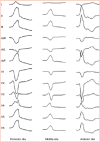Electrocardiographic Criteria for Differentiating Left from Right Idiopathic Outflow Tract Ventricular Arrhythmias
- PMID: 33936738
- PMCID: PMC8076969
- DOI: 10.15420/aer.2020.10
Electrocardiographic Criteria for Differentiating Left from Right Idiopathic Outflow Tract Ventricular Arrhythmias
Abstract
Idiopathic ventricular arrhythmias are ventricular tachycardias or premature ventricular contractions presumably not related to myocardial scar or disorders of ion channels. Of the ventricular arrhythmias (VAs) without underlying structural heart disease, those arising from the ventricular outflow tracts (OTs) are the most common. The right ventricular outflow tract (RVOT) is the most common site of origin for OT-VAs, but these arrhythmias can, less frequently, originate from the left ventricular outflow tract (LVOT). OT-VAs are focal and have characteristic ECG features based on their anatomical origin. Radiofrequency catheter ablation (RFCA) is an effective and safe treatment strategy for OT-VAs. Prediction of the OT-VA origin according to ECG features is an essential part of the preprocedural planning for RFCA procedures. Several ECG criteria have been proposed for differentiating OT site of origin. Unfortunately, the ECG features of RVOT-VAs and LVOT-VAs are similar and could possibly lead to misdiagnosis. The authors review the ECG criteria used in clinical practice to differentiate RVOT-VAs from LVOT-VAs.
Keywords: Idiopathic ventricular arrhythmia; catheter ablation; electrocardiogram; ventricular outflow tract.
Copyright © 2021, Radcliffe Cardiology.
Conflict of interest statement
Disclosure: The authors have no conflicts of interest to declare.
Figures




Similar articles
-
A novel electrocardiographic criterion for differentiating a left from right ventricular outflow tract tachycardia origin: the V2S/V3R index.J Cardiovasc Electrophysiol. 2014 Jul;25(7):747-53. doi: 10.1111/jce.12392. Epub 2014 Mar 19. J Cardiovasc Electrophysiol. 2014. PMID: 24612087
-
Reasons for failed ablation for idiopathic right ventricular outflow tract-like ventricular arrhythmias.Heart Rhythm. 2013 Aug;10(8):1101-8. doi: 10.1016/j.hrthm.2013.05.011. Epub 2013 May 20. Heart Rhythm. 2013. PMID: 23702237
-
V3R/V7 Index: A Novel Electrocardiographic Criterion for Differentiating Left From Right Ventricular Outflow Tract Arrhythmias Origins.Circ Arrhythm Electrophysiol. 2018 Nov;11(11):e006243. doi: 10.1161/CIRCEP.118.006243. Circ Arrhythm Electrophysiol. 2018. PMID: 30571180
-
Electrocardiographic features, mapping and ablation of idiopathic outflow tract ventricular arrhythmias.J Interv Card Electrophysiol. 2020 Mar;57(2):207-218. doi: 10.1007/s10840-019-00617-9. Epub 2019 Oct 24. J Interv Card Electrophysiol. 2020. PMID: 31650457
-
Catheter Ablation of Idiopathic Ventricular Arrhythmias Arising From the Cardiac Outflow Tracts - Recent Insights and Techniques for the Successful Treatment of Common and Challenging Cases.Circ J. 2016 Apr 25;80(5):1073-86. doi: 10.1253/circj.CJ-16-0293. Epub 2016 Apr 13. Circ J. 2016. PMID: 27074752 Review.
Cited by
-
[Catheter ablation of ventricular tachycardia-Update 2023].Herz. 2023 Jun;48(3):247-256. doi: 10.1007/s00059-023-05167-5. Epub 2023 May 2. Herz. 2023. PMID: 37130946 German.
-
Automatic and interpretable prediction of the site of origin in outflow tract ventricular arrhythmias: machine learning integrating electrocardiograms and clinical data.Front Cardiovasc Med. 2024 Mar 20;11:1353096. doi: 10.3389/fcvm.2024.1353096. eCollection 2024. Front Cardiovasc Med. 2024. PMID: 38572307 Free PMC article.
-
Training machine learning models with synthetic data improves the prediction of ventricular origin in outflow tract ventricular arrhythmias.Front Physiol. 2022 Aug 12;13:909372. doi: 10.3389/fphys.2022.909372. eCollection 2022. Front Physiol. 2022. PMID: 36035489 Free PMC article.
-
RV1+RV3 Index to Differentiate Idiopathic Ventricular Arrhythmias Arising From Right Ventricular Outflow Tract and Aortic Sinus of Valsalva: A Multicenter Study.J Am Heart Assoc. 2024 Apr 2;13(7):e033779. doi: 10.1161/JAHA.123.033779. Epub 2024 Mar 27. J Am Heart Assoc. 2024. PMID: 38533964 Free PMC article.
-
Electrical and Structural Insights into Right Ventricular Outflow Tract Arrhythmogenesis.Int J Mol Sci. 2023 Jul 22;24(14):11795. doi: 10.3390/ijms241411795. Int J Mol Sci. 2023. PMID: 37511554 Free PMC article. Review.
References
-
- Yamada T,, Doppalapudi H,, McElderry HT, et al. Idiopathic ventricular arrhythmias originating from the papillary muscles in the left ventricle: prevalence, electrocardiographic and electrophysiological characteristics, and results of the radiofrequency catheter ablation. J Cardiovasc Electrophysiol. 2010;21:62–9. doi: 10.1111/j.1540-8167.2009.01594.x. - DOI - PubMed
Publication types
LinkOut - more resources
Full Text Sources

